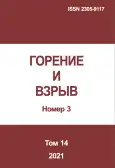Development of chain models of the dynamics of the COVID-19 pandemic spread
- Authors: Goldberg V.M.1
-
Affiliations:
- N. M. Emanuel Institute of Biochemical Physics, Russian Academy of Sciences
- Issue: Vol 14, No 3 (2021)
- Pages: 3-10
- Section: Articles
- URL: https://journal-vniispk.ru/2305-9117/article/view/288575
- DOI: https://doi.org/10.30826/CE21140301
- ID: 288575
Cite item
Abstract
The work confirms the correctness of the mathematical model of the spread of the coronavirus pandemic as a branched chain (autocatalytic) reaction. The results of the interpretation of statistical data within the framework of this model for the already completed — the first and second — and the ongoing (in May–June 2021) third waves of coronavirus for the city (Moscow), region (Yakutia), and country (Russia) are presented. The quantitative parameters of the logistic function were obtained which satisfactorily describe the spread of the pandemic in these three research objects. The model has predictive capabilities. It was shown that the constancy of the infection rate after a decrease in this value means the beginning of the next wave of coronavirus. The start date and the number of people infected in it can also be determined in advance. So, for the third wave of coronavirus which takes place in June 2021, using the model, the number of people who will be infected in the third wave of coronavirus and the time of its beginning were determined. Some of the patterns found are universal. In particular, the effective rate constant decreases with the transition from the first wave to the second. This can be explained by the growth of the so-called herd immunity. The model calculates a dynamic constant associated with the probability of infection for one person. This constant can change by more than two orders of magnitude when moving from one region to another.
About the authors
Vladimir M. Goldberg
N. M. Emanuel Institute of Biochemical Physics, Russian Academy of Sciences
Author for correspondence.
Email: goldberg@sky.chph.ras.ru
Doctor of Science in chemistry, senior research scientist
Russian Federation, 4 Kosygin Str., Moscow 119334References
- Zlojutro, A., D. Rey, and L. Gardner. 2019. A decision-support framework to optimize border control for global outbreak mitigation. Sci. Rep. — UK 9:2216.
- Krivorot’ko, O. I., S. I. Kabanikhin, N. Y. Zyat’kov, A. Yu. Prikhod’ko, N. M. Prokhoshin, and M. A. Shishlenin. 2020. Mathematical modeling and forecasting of COVID-19 in Moscow and Novosibirsk region. Numer. Analys. Appl. 13:332–348. doi: 10.1134/ S1995423920040047.
- Coronavirus COVID-19 Global Cases by the Center for Systems Science and Engineering (CSSE) at Johns Hopkins University. Available at: https://gisanddata.maps.arcgis.com/apps/opsdashboard/index.html#/bda7594740fd40299423467b48e9ecf6 (accessed March 21, 2020).
- Tamm, M. V. 2020. Koronavirusnaya infektsiya v Moskve: prognozy i stsenarii [COVID-19 in Moscow: Prognoses and scenarios]. FARMAKOEKONOMIKA. Modern Pharmacoeconomic Pharmacoepidemiology 13(1):43–51. doi: 10.17749/2070-4909.2020.13.1.43-51.
- Koltsova, E. M., E. S. Kurkina, and A. M. Vasetsky. 2020. Mathematical modeling of the spread of COVID-19 in Moscow and Russian regions. arXiv:2004.10118 [q-bio.PE].
- Chen, Y., J. Cheng, Y. Jiang, and K. Liu. 2020. A time delay dynamical model for outbreak of 2019-nCoV and the parameter identification. J. Inverse Ill-Pose. Pr. 28(2):243–250.
- Goldberg, V. M. 2020. Dynamics of coronavirus spread in terms of chemical reaction kinetics. Russ. Chem. B. 69(10): 2022–2028.
Supplementary files










